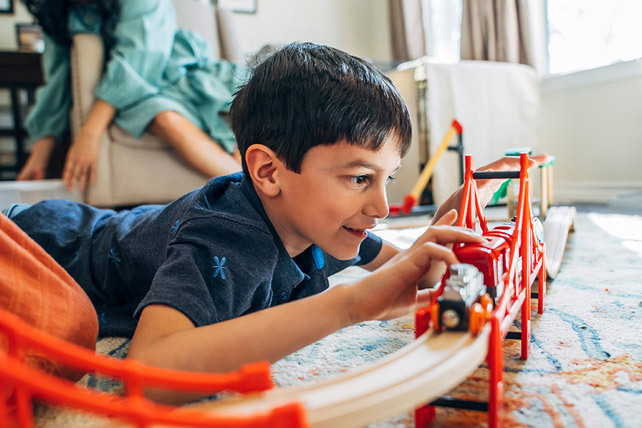What about Trauma?
As we attempt to weave together these thoughts on a developmentally appropriate manner to work with traumatized children, I would like to comment on some basic views I have in my work with traumatized clients:
- Trauma is, by nature, intrusive. Therefore, the therapist’s interventions should be facilitative and not a recapitulation of this intrusion. The promotion of the child’s self-expression provides the freedom to explore and grow.
- Trauma always occurs within the framework of a system of some kind (most often the family). The trauma may have happened because of the family. Regardless, a systemic/family therapy approach must be a crucial element of the therapeutic milieu.
- Treatment must attend to a continuum of issues—including physiological, cognitive, psychological, and spiritual concerns. Trauma involves various levels of impact to any and all of these areas.
- Clinical work in the area of trauma often involves direct encounters with horrifying circumstances. The professional and personal impact on therapists should never be underestimated.
- The focus of treatment should never be the trauma itself, the clinical diagnosis, or even the child’s symptomatic response to the trauma. Instead, it should always be the child. If we focus on other elements, we lose sight of the child.
- Trauma treatment takes time. It is unrealistic, unreasonable, and unethical to expect that two, five, or 10 years of trauma, neglect, terror, and pain will resolve itself by six or eight sessions by managed care for an hour once a week. We should fight for what the children need.
It is also important to briefly touch upon the neurobiological effects of trauma. Neuroimaging studies with post-traumatic stress disorder (PTSD) clients demonstrates: 1) deactivation of the prefrontal cortex (executive functioning), which interferes with the ability to formulate a measured response to a threat; 2) increased activation of the limbic system; and 3) decreased activation in the Broca’s area in the brain, which relates to verbalization (van der Kolk, 2014). To ask the “classic” counseling question—“How does that make you feel?”—makes little sense in light of these neurological realities alone.
Traumatized clients need a soothing intervention. Trauma leaves clients’ brains in an alarm state, where alarm reactions trump cortical processing (Perry, 2006; van der Kolk, 2006, 2014). The cortex can be overwhelmed by lower brain regions; thus, expressive interventions, which do not rely on verbal processing and executive functioning, help soothe clients who may have alarm reactions in the therapy process. Perry and Hambrick (as cited in Gaskill & Perry, 2012) emphasize that “… until state regulation or healthy homeostasis is established at the brainstem level, higher brain mediated treatments will be less effective” (p. 40).
van der Kolk (2014) argues that trauma always involves speechless terror—that traumatized clients are basically unable to put feelings into words and, thus, left with intense emotions that cannot be fully verbalized. If the children we work with are in this state because of neurobiological realities—or simply because of their development level—we should never force them to verbalize.
Conclusion
When working with traumatized children, my primary goals are: 1) Give hope to children/parents; 2) Provide children with a safe, reparative, and relational experience so development and potential may be realized; and 3) Provide a developmentally appropriate and honoring therapy experience. I believe this is accomplished through play and expressive therapies.
Although I am unable to deliver practical intervention material in such a short article, I encourage readers to consider some of the resources on the reference list provided. More importantly, I always try to remember these two crucial elements: therapeutic relationships are essential on all levels, and being developmentally appropriate is honoring. Neale (1969) wrote, “Consider the play of the child, and the nature of the Kingdom will be revealed. Christ is that fiddler who plays so sweetly that all who hear him begin to dance” (p. 174). For the sake of the children, let’s join in the play.
This article originally appeared in Christian Counseling Today, Vol. 24 No. 4. Christian Counseling Today is the flagship publication of the American Association of Christian Counselors. To learn more about the AACC, click here.
References
Gaskill, R., and Perry, B. (2014). The neurobiological power of play: Using the neurosequential model of therapeutics to guide play in the healing process. In C. Malchiodi & D. Crenshaw (Eds.), Creative arts and play therapy for attachment problems (pp. 178-196). New York: Guilford Press.
Homeyer, L., and Sweeney, D. (2017). Sandtray therapy: A practical manual (3rd ed.). New York: Routledge.
Landreth, G. (2012). Play therapy: The art of the relationship (3rd ed.). New York: Routledge.
Perry, B. (2006). Applying principles of neurodevelopment to clinical work with maltreated and traumatized children: The neurosequential model therapeutics. In N.B. Webb (Ed.), Working with traumatized youth in child welfare (pp. 27-52). New York: Guilford Press.
Sweeney, D., and Lowen, M. (2018). A developmentally appropriate treatment approach for traumatized children and adolescents. In H. Gingrich & F. Gingrich (eds.), Treating trauma in Christian counseling. Downers Grove, IL: InterVarsity Press Academic.
Sweeney, D. (1997). Counseling children through the world of play. Wheaton, IL: Tyndale Publishing House.
van der Kolk, B. (2014). The body keeps the score: Brain, mind, and body in the healing of trauma. New York: Penguin Group.
van der Kolk, B. (2006). Clinical implications of neuroscience research in PTSD. Annals of the New York Academy of Science, 1071(IV), 277-293.

